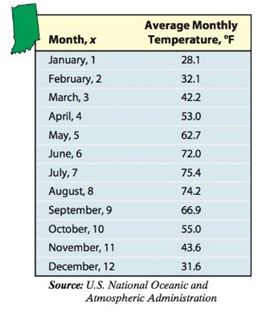
Monthly Temperature The given data represent the average monthly temperatures for Indianapolis, Indiana.
(a) Draw a
(b) Find a sinusoidal function of the form that models the data.
(c) Draw the sinusoidal function found in part on the scatter diagram.
(d) Use a graphing utility to find the sinusoidal function of best fit.
(e) Graph the sinusoidal function of best fit on a scatter diagram of the data.

Want to see the full answer?
Check out a sample textbook solution
Chapter 6 Solutions
Precalculus Enhanced with Graphing Utilities, Books a la Carte Edition Plus NEW MyLab Math -- Access Card Package (7th Edition)
Additional Math Textbook Solutions
Introductory Statistics
A First Course in Probability (10th Edition)
College Algebra (7th Edition)
Thinking Mathematically (6th Edition)
Calculus for Business, Economics, Life Sciences, and Social Sciences (14th Edition)
- In Problems 10-4, use the method of undetermined coefficients to determine the form of a particular solution for the given equation.arrow_forwardIn Problems 10-40, use the method of undetermined coefficients to determine the form of a particular solution for the given equation. 2 1. y"" - 2y" - 5y/+6y= e² + x²arrow_forwardUse Euler and Heun methods to solve y' = 2y-x, h=0.1, y(0)=0, compute y₁ys, calculate the Abs_Error.arrow_forward
- The twice differentiable functions fand g are defined for all real numbers of x. Values of f(x) and g(x) for various values of x are given in the table below. Evaluate (f'(g(x))g'(x)dx. -2 X -2 −1 1 3 f(x) 12 8 2 7 g(x) -1 03 1arrow_forwardWrite an integral that is approximated by the following Riemann sum. Substitute a into the Riemann sum below where a is the last non-zero digit of your banner ID. You do not need to evaluate the integral. 2000 (10 1 ((10-a) +0.001) (0.001)arrow_forwardEach of the following statements is an attempt to show that a given series is convergent or divergent using the Comparison Test (NOT the Limit Comparison Test.) For each statement, enter C (for "correct") if the argument is valid, or enter | (for "incorrect") if any part of the argument is flawed. (Note: if the conclusion is true but the argument that led to it was wrong, you must enter I.) ☐ 1. For all n > 1, seriesΣ In(n) In(n) converges. 2, 1, arctan(n) the series arctan(n) n³ ☐ 4. For all n > 1, 123 converges. 1 n ln(n) series In(n) diverges. 2n . and the seriesΣconverges, so by the Comparison Test, 2, 3, and the series converges, so by the Comparison Test, the series-3 1 converges. ☐ 6. For all n > 2, In(n) >, and the series Σ converges, so by the Comparison Test, the seriesΣ In(n) converges.arrow_forward
- Instructions. "I have written solutions in text form, but I need experts to rewrite them in handwriting from A to Z, exactly as I have written, without any changes."arrow_forwardBoth in images okk. Instructions. "I have written solutions in text form, but I need experts to rewrite them in handwriting from A to Z, exactly as I have written, without any changes."arrow_forwardQuestion 1: If a barometer were built using oil (p = 0.92 g/cm³) instead of mercury (p = 13.6 g/cm³), would the column of oil be higher than, lower than, or the same as the column of mercury at 1.00 atm? If the level is different, by what factor? Explain. (5 pts) Solution: A barometer works based on the principle that the pressure exerted by the liquid column balances atmospheric pressure. The pressure is given by: P = pgh Since the atmospheric pressure remains constant (P = 1.00 atm), the height of the liquid column is inversely proportional to its density: Step 1: Given Data PHg hol=hgx Poil • Density of mercury: PHg = 13.6 g/cm³ Density of oil: Poil = 0.92 g/cm³ • Standard height of mercury at 1.00 atm: hμg Step 2: Compute Height of Oil = 760 mm = 0.760 m 13.6 hoil = 0.760 x 0.92 hoil = 0.760 × 14.78 hoil = 11.23 m Step 3: Compare Heights Since oil is less dense than mercury, the column of oil must be much taller than that of mercury. The factor by which it is taller is: Final…arrow_forward
- Question 3: A sealed flask at room temperature contains a mixture of neon (Ne) and nitrogen (N2) gases. Ne has a mass of 3.25 g and exerts a pressure of 48.2 torr. . N2 contributes a pressure of 142 torr. • What is the mass of the N2 in the flask? • Atomic mass of Ne = 20.1797 g/mol • Atomic mass of N = 14.0067 g/mol Solution: We will use the Ideal Gas Law to determine the number of moles of each gas and calculate the mass of N2. PV = nRT where: • P = total pressure • V volume of the flask (same for both gases) n = number of moles of gas • R 0.0821 L atm/mol K • T = Room temperature (assume 298 K) Since both gases are in the same flask, their partial pressures correspond to their mole fractions. Step 1: Convert Pressures to Atmospheres 48.2 PNe = 0.0634 atm 760 142 PN2 = = 0.1868 atm 760 Step 2: Determine Moles of Ne nNe = mass molar mass 3.25 nNe 20.1797 nne 0.1611 mol Step 3: Use Partial Pressure Ratio to Find narrow_forward"I have written solutions in text form, but I need experts to rewrite them in handwriting from A to Z, exactly as I have written, without any changes."arrow_forward3.12 (B). A horizontal beam AB is 4 m long and of constant flexural rigidity. It is rigidly built-in at the left-hand end A and simply supported on a non-yielding support at the right-hand end B. The beam carries Uniformly distributed vertical loading of 18 kN/m over its whole length, together with a vertical downward load of 10KN at 2.5 m from the end A. Sketch the S.F. and B.M. diagrams for the beam, indicating all main values. Cl. Struct. E.] CS.F. 45,10,376 KN, B.M. 186, +36.15 kNm.7arrow_forward
- Algebra & Trigonometry with Analytic GeometryAlgebraISBN:9781133382119Author:SwokowskiPublisher:Cengage
